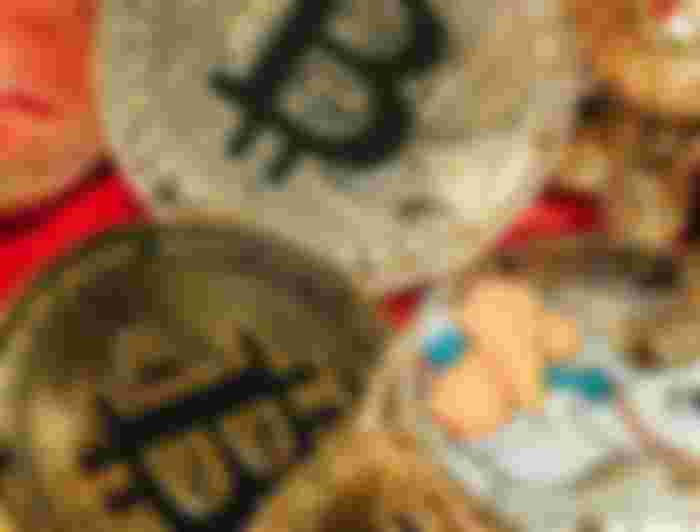The beginner's Guide to DeFi, everything you Need to Know.
What is defi
The term “Defi” is used to refer to decentralized finance, in English, Decentralized Finances.

In this sense, whenever we hear that word, we are referring to a new way of using your money. Defi makes it possible to use financial instruments from the traditional world in a decentralized way through smart contracts (pre-programmed requirements that are only executed if they comply with the
rules), such as loans, being a market maker, participating in the governance of a decentralized application (as if they were shares of a company), taking out loans, using brokers in a decentralized manner (DEX), among countless other things.
But it is important to know what something decentralized is.
Decentralization occurs when in a network there is not only one person or a small group of them who can change something, decide rules or change the way it works, but there are several different points that are interconnected, requiring a consensus between them so that something can happen. occur.
The difference between the traditional way of using financial instruments and the way that is used in Defi is that, if you are going to use one in the traditional way, such as taking a loan from a bank, there are a lot of bureaucracy and impediments that the bank can submit to you, in addition, there is always a third party where trust must be placed, from the possession of your money until that bank will collect
interest correctly. In Defi, you don't need to trust third parties, so you only need to trust the pre-programmed code where the rules are all pre-established, besides being horizontal and democratic.
Because it is decentralized, no one is able to differentiate you and prohibit you from trading within a decentralized exchange, you cannot be prevented from borrowing because of your low income, no one will prohibit you from lending money because of your skin color, height or nationality.
All are equal.
To participate in this world you will only need a wallet, where you will connect it with some decentralized application and thus be happy, without giving personal data to anyone, in a pseudo-anonymous and free way.
all about wallets
It is extremely important to know that whenever you are going to use any decentralized finance, from DEX's to loan applications, you will need to use a wallet. In a decentralized environment, the wallet will be your identity, that is, to use Dapps, you will not inform your data, such as ID, name, or anything like that, you will only connect your wallet and you will be able to use what that
application provide.
Therefore, knowing how a portfolio works is essential. From how to store your 12 backup words safely, outside of digital media, to how to add a token contract inside the metamask.
For people who already have physical wallets, such as Trezor or Ledger, they can use them connected to other wallets, which brings even more security to the process, as the validation and creation of the backup words will be done offline. line.
The most used wallets for connecting to decentralized applications are:
Metamask (ETH Network, BSC Network, Polygon, ...), Kepler (Cosmos Network), Phantom (Solana Network).
All of these will work as an extension of your browser that, after being added as an extension, every time your browser is closed and reopened, you will need to enter a password in order to access it, thus promoting greater security.
Sending and receiving tokens works like any other wallets, remembering that for all tokens on a network the address remains the same. And if a token you have sent to your Metamask does not appear, just access CoinMarketCap, copy and paste the token contract into the metamask and it will appear.
Reminder: NEVER REVEAL YOUR BACKUP WORDS TO ANYONE.
No decentralized application will ask for them, and if they do, it's a SCAM.
Main Protocols
With the basics explained, now let's get down to business.
What protocols should I start putting my money into? What does each one do? Is there a difference between them? Which ones do people trust the most? All this I will now explain to you.
Let's start with Decentralized exchanges, or better known as decentralized exchanges. In them we can exchange tokens at will, paying only a fee to the liquidity providers and a fee to the network miner, who will validate your exchange. To make it simpler, I will separate the networks (Ethereum, Binance Smart Chain and Cosmos) each with their main ones:
1.Ethereum Network: Uniswap, 1inch and Curve Finance
2.BSC network: Pancake swap, Ellipses and MDex
3.Cosmos Network: Emeris and Osmosis
“Ok, I understand that these are the most reliable, now, how am I going to monetize my money inside those DEXs?” There are two ways, Staking or providing liquidity for a pair of tokens.
In addition, there are protocols focused in loans, where you can lend from stablecoins to tokenized bitcoin to lending pools, allowing you to receive interest for it. And the most liquid are:
1.Ethereum Network: MakerDao, Compound and AAVE
2.BSC network: Alpaca finance and Venus
In addition to those mentioned, there are others that do the same thing, but it is necessary to remember that security when it comes to defi is fundamental, so I recommend focusing on protocols where you already have a lot of money deposited and longer life, even paying a slightly lower yield.
Loans, Staking and more
These are the three most famous methods of monetizing your money and I will explain what each one is.
At first, in loans, you add your tokens to a pool of
loan, which can be any currency that the protocol accepts, and for
As a result, you will receive interest for it. The contract is made in a way where there is a guarantee that the other party will fulfill its part by paying you interest, ensuring that the yields come in the right way, remembering that in Defi, yields are also volatile.
Staking is a way for you to participate in the governance of a protocol.
Remembering that there is a difference between the stake in a defi protocol and the stake of coins for network validation.
Each protocol normally has the token that represents the project. Pancake Swap has its CAKE token, Uniswap has the UNI token, 1inch has its 1INCH token, that is, these tokens work as if they were stocks in the traditional world and whoever buys them believes in this protocol. By purchasing these tokens, it is possible to place them in
a Staking pool, where you will receive part of the new tokens issued by the network and a part of the cash flow (which can be compared with dividends).
The most complex is the one that involves the greatest risk, however, the greatest return is providing liquidity for a pair of tokens. First, it is necessary to understand why it is necessary to provide liquidity for two tokens.
On a centralized exchange like Binance, the liquidity of an asset is measured by its order book. In this mode, there are buyers called Bid and sellers called Ask, where they put in an order book how much they want to pay or receive for that asset, being necessary to reach a consensus for the order to be executed.

When creating decentralized brokerages, the problem that, to interact with the blockchain and place an order on the Book, it would be necessary to pay a fee and wait a few seconds for that to be approved by the miner, however, the market is very dynamic and 15 seconds for an order to be executed can change many stuff. If it was also necessary to cancel an order, you would have to pay another fee again.
Understanding that this method is not at all efficient for making exchanges in a decentralized environment, the method of having liquidity through these pools was created, where anyone can create an LP token (liquidit provider) between two tokens, making the counterparty sell or buy whenever someone wants, automatically and receiving a fee for it.
Assuming I have ETH and USDC in my wallet at a ratio of 50% ETH and 50% USDC (equal amount in dollar amount), I can make this LP token between ETH and USDC, add it to the pool and start monetizing it, receiving fee from those who exchange ETH for USDC or vice versa.
However, due to the automatic rebalancing between the tokens, according to their price variation, a phenomenon called Impermanent loss occurs, and this is where the risk of making an LP token lives. Due to this, it is also necessary to elaborate an entry and exit strategy, calculate the possible Impermanent loss compared to profitability, among other several factors. And usually farms are medium/long term strategies.
Now let's see in practice what Impermanent loss is and how to protect yourself from it. As the name itself tells us, it is an impermanent loss, or even a momentary loss. This loss can be compared to an unrealized loss.
This phenomenon occurs when when making an LP token between two volatile tokens, there is a variation in the price where the 50% proportion between both tokens (in dollars) becomes different, and through automatic rebalancing you get more than
token that has devalued and less than the token that has appreciated to maintain the 50% proportion. However, by doing this, the value of the between both tokens is lower than if you had simply kept both tokens in your wallet and not provided liquidity. Because of this potential risk, the return for providing liquidity is often
be tall.
To protect yourself, I recommend choosing to provide liquidity between two tokens where their dollar prices are correlated:
- ETH/BTC
- BNB/CAKE
- LINK/UNI
- ETH/UNI
This will make sure that if one of the tokens goes up, the other one will follow, decreasing the chance of impermanent loss.
Few people talk about it, but providing liquidity between a volatile token and a stablecoin is a great choice despite the impermanent loss is almost a certainty.
In a reduced way, when making an LP such as ETH/USDC or BNB/BUSD, if the volatile token rises, the LP appreciates less than the token alone, but when it falls, the loss is also smaller, that is, it amortizes gains and losses, in addition to usually offering good returns.
Ethereum, BSC, AVAX
The first cryptocurrency that added smart contracts to its blockchain was Ethereum. As a result, a complete ecosystem of decentralized applications was created.
Because it is the first, the most consolidated, tested and secure applications are in it. The Maker protocol was one of the first to be created, enabling a decentralized stablecoin, Uniswap was one of the first DEX that existed in the decentralized environment, among others. This brought a robustness to the ecosystem as a whole and caught the attention of many investors due to its boiling innovations, but the Ethereum network is not scalable, having very high fees for
transact, making it impossible for investors with less capital to enjoy this ecosystem.
With this problem in mind, because Ethereum is open source, the Binance exchange had the idea of integrating smart contracts into its existing Binance Chain network, but they thought it better to create one from scratch, thus giving rise to Binance Smart Chain, a blockchain also programmed. in solidity but with much lower rates and scalable, giving up some of the decentralization.
For a beginner, it is recommended to start with her. Because the cost is lower, you can test several applications and if an error is made, you won't be spending absurd fees to undo it. It is the second largest network and despite having only 21 validation nodes, Binance has no direct influence on what happens on the network, as CZ (Ceo and founder of Binance) says.
Cosmos, on the other hand, needs a little more knowledge to use it with mastery, since there is the IBC (inter blockchain communication).
But once this is learned, it works like any other Defi, with cheap rates, decentralized and scalable, one of the most promising ecosystems for the next few years.

trading strategies
This part can vary from person to person depending on their willingness to take risks, but I will go through what I believe to be the most efficient and with a controlled risk, always thinking about survival and not just profit.
First, the network on which you are using Defi matters a lot because of the rate. As on the Ethereum network the fees are more salty, a short-term exposure is usually not worth it, on networks where the fees are almost negligible, short-term exposures or aiming for a potential return of a lower percentage are welcome. With that in mind, execute the plan that fits what you use.
It is very important that you manage your crypto portfolio in percentages, for example: 60% Bitcoin, 15% Ethereum, 10% cardano, 10% Polkadot and 5% BNB (fictitious values, do not copy this). With this division in mind, the part directed to Defi should not be a share greater than 20% of all its capital, because although consolidated platforms are secure, we see attacks on protocols, networks not
robust are down, bug in smart contracts, so don't go in with euphoria and set aside a higher risk part to allocate to Defi.
Entry strategies that I use in my personal portfolio are to separate most of my capital from Defi to allocate to more consolidated projects that yield me not so high, but constant yields, such as, for example, providing liquidity between two tokens that I intend to hold, Stake of consolidated currencies, such as Cake, 1inch, among others. It is always good, too, to have a base on graphical analysis to know
what moment of the asset you are entering, so as not to buy currencies in top or very stretched regions. I also recommend always making partial entries and exits, this way, you avoid trying to find top or bottom, but rather make an average price, something that is much calmer for your emotional and more efficient in the long run.
Risk Management

In situations where the stake needs to lock the coins, the strategy needs to be sharper. An example that happened recently was the o3 stake, the o3 swap protocol token. In it, to staking it was necessary to lock your coins for 2 months, this would make the coin have an absurd demand for purchase because the staking yield, at the beginning, was close to 3000%. But as the
locking the tokens make it impossible for you to sell, it is common that on the day you release the tokens, there is an eviction of it on the market, with very strong selling pressure.
Given this, it is prudent to set aside 50% for staking to take advantage of the High Yield, but also leave 50% free for speculation, thus allowing you to take the risk as soon as the currency appreciates.
And the basics for riskier protocols or air drops is always to eliminate the risk as soon as possible, leaving only the profit yielding for you, doing this constantly, your gains will be constant and with the risk reduced.
The risks of investing in a defi protocol can be divided into layers, also called Money legos.
Thinking of a pyramid to represent the risks, its base would be the chosen blockchain. In case you have your money on a blockchain that suffers an attack and goes down or ceases to exist, everything above it collapses together, protocols, tokens, applications, literally everything. Given that, blockchain is the biggest risk of all.
On a layer above is the risk of the custody of your tokens. Knowing how to create a wallet, keep your passwords correctly, have a physical wallet, a good antivirus is essential for your own security, because without it there is no point in exposing yourself to good protocols.
Then comes the security of the protocol itself and its smart contracts. If the place where your money is
applied is malicious or has poorly programmed smart contracts, full of bugs, this will cause damage to your applications, ranging from the protocol going off the map, to being hacked and you lose all your tokens.
And the last risk, if it can be called that, is the volatility of the token and the impermanent loss, which not only occurs in Defi but always when investing in something volatile. Having all the risks pointed out, select your application well and diversify to minimize possible losses.
B L O C K C H A I N
BSC Network: bscscan.com
ETH Network: etherscan.com
Comos network: Mintscan.com
Every blockchain has its explorer, which is nothing more than a website that
shows transactions, tokens, contracts, addresses and other information about a blockchain in a didactic way.
With them, you can find out:
- Mined blocks (Who mined, total transactions, block size, total fees paid).
-Token contract, ranging from holders, open source, contract, circulating supply, among other things
-Check your address on the blockchain
-View all transactions already made by all addresses.



